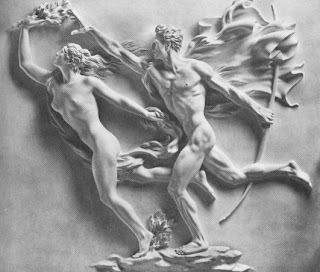Anti-Art
The rabbis may not have forbidden
The making of images
For religious reasons.
Perhaps they foresaw
The leprous eyesores
Their unghettoed artists
Would flush
From chisel
And brush.
- Anonymous
The rabbis may not have forbidden
The making of images
For religious reasons.
Perhaps they foresaw
The leprous eyesores
Their unghettoed artists
Would flush
From chisel
And brush.
- Anonymous
The Combat League for German Culture (Kampfbund für Deutsche Kultur) was established by Alfred Rosenberg in 1929. The concept of Cultural Bolshevism (Kulturbolschewismus) was applied to modern art, which was in those days, as now, in many ways, degenerate.This was linked to a Jewish-Communist conspiracy to undermine the beauty-ideal of the Aryan race.
| Blind Musician, by Finnish Expressionist painter Alvar Cawén |
In the early 20th century, modern art movements like cubism and surrealism were becoming popular. The Nazis viewed these art forms with suspicion, characterizing them as “degenerate”. According to Nazi theorists, such works were created by those who were so corrupted and morally enfeebled by modern life that they had lost the capability of producing coherent art. Impressionist and Expresssionist art is marked by ‘painterliness’, in which brushstrokes are applied in a less than controlled manner, thus being impulsive in nature.
 |
| The Birth of Venus (La Nascita di Venere) by Sandro Botticelli |
When these modern art forms first began their rise to popularity, many thought of these as elitist, incomprehensible and morally suspect.
The Nazis stressed that artists must work for the broad masses of people, and not for other artists. In other words, works of art should be comprehensible to ordinary people and not ‘esoteric’.
Amongst the most vocal proponents of the Nazi idea of art was the architect Paul Schultze-Naumburg. According to him, artists paint according to what they see and perceive, which in turn is conditioned by who they are, especially their race. The art of ancient Greece and Rome were the ideals to be emulated, and their depiction of timeless concepts of classical beauty was a sign of racial purity and superiority. Depiction of the idealized human form was good art, whereas the tendency of modernist art to depict deformed and abstract human forms was condemned as indicators of racial and moral degeneracy. He condemned the propensity of many modernist artists to imitate ‘Negro art’, while at the same time praising genuine African art of being great.
The Nazi regime was unmatched in its devotion to totally interfere in art, architecture, films, theater, music and literature. In 1933 the Reichskulturkammer (Reich Culture Chamber) was established, with Joseph Goebbels as its chief. He, however, did not believe that Expressionism should be considered an example of degenerate art. This viewpoint was vehemently opposed by Alfred Rosenberg, who despised Expressionism. The controversy was finally settled when Hitler himself ruled finally that there was no place for any kind of modernist experimentation in the Reich, including Expressionism.
In music, again classical music was admired, jazz was frowned upon, cabarets were stopped, and atonal music (music that lacks a tonal center, or key) was banned.
The Nazi approach to art can properly be called romantic realism, which in essence means taking an idealized and romantic view of reality.
 |
| Farm Family from Kahlenburg by Adolf Wissel, a typical example of Nazi-favored art |
 |
| A typical work by Arno Breker |
Typical of the Nazi approach to art is the work of the sculptor Arno Breker. Hitler loved Breker’s work. These sculptures, which depicted flawless and idealized bodies, represented to Alfred Rosenberg the “mighty momentum and willpower (Wucht und Willenhaftigkeit) “, that was to propel National Socialist Germany to last a thousand years. Most of Breker’s work survived the war, but a majority of his sculptures were destroyed by the Allies after the war.
 |
| Adolf Hitler in Paris. To his right is Albert Speer. To his left is Arno Breker. |
Breker himself was fined but not otherwise harassed. He continued to work after that, and was commissioned by King Hassan II of Morocco for an important building in Casablanca. But controversy rose, and the work was demolished.
Postering was an important element in art during the Nazi regime, in which lighting was skilfully used to create the impression of dedication, bravery and power.
 |
| Poster for the exhibition |
Interesting in this context is the case of Emil Nolde. Nolde is considered one of the great waercolor painters of the 20th century. His style is distinctly expressionistic. From the early years of the National Socialist movement, Nolde was its supporter. He considered Expressionism to be a distinctly Germanic style.
 |
| Blumengarten, by Emil Nolde |
However, as mentioned above, there were serious differences of opinion amongst top Nazis with respect to Expressionism; Rosenberg and his group opposing it, Goebbels and his group supporting it. With Hitler finally ruling against Expressionism, Nolde, despite being an ardent Nazi, was prohibited from painting, even in private. Most of his work was seized. Many were included in the Degenerate Art exhibition, despite Nolde’s personal appeal to Baldur von Schirach, the governor of Vienna and head of the Hitler Youth. During the period of the ban, he secretly painted many watercolors, which he called the ‘unpainted paintings’. Nolde was again honored after the war, receiving West Germany’s highest civilian decoration.
The ideas of art so forcefully propagandized in Nazi Germany have today largely been abandoned, except for the so-called Art Deco, which has much of the same features. Art Deco has undergone a recent resurgence and is much used in graphic design and in advertisements for jewelry, fashion and toiletries.
Bombay has one of the largest number of buildings in the world built in the Art Deco style of architecture, including many old movie theaters like
Eros, New Excelsior, New Empire and Liberty.
No comments:
Post a Comment